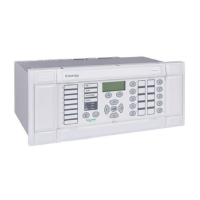Commissioning P54x/EN CM/La4
MiCOM P543, P544, P545 & P546
CM) 10-63
CM
If cell [0D02: MEASURE’T. SETUP, Local Values] is set to ‘Primary’, the values displayed
should be equal to the applied secondary voltage multiplied the corresponding voltage
transformer ratio set in the ‘CT & VT RATIOS’ menu column (see Table 10). Again the
values should be within 1% of the expected value, plus an additional allowance for the
accuracy of the test equipment being used.
11.1.2 Current connections
Measure the
current transformer secondary values for each input using a multimeter
connected in series with the corresponding relay current input.
Check that the current transformer polarities are correct by measuring the phase angle
between the current and voltage, either against a phase meter already installed on site and
known to be correct or by determining the direction of power flow by contacting the system
control center.
Ensure the current flowing in the neutral circuit of the current transformers is negligible.
Compare the values of the secondary phase currents and phase angle with the relay’s
measured values, which can be found in the MEASUREMENTS 1 menu column.
If cell [0D02: MEASURE’T. SETUP, Local Values] is set to ‘Secondary’, the currents
displayed on the LCD or a portable PC connected to the front EIA(RS)232 communication
port of the relay should be equal to the applied secondary current. The values should be
within 1% of the applied secondary currents. However, an additional allowance must be
made for the accuracy of the test equipment being used.
If cell [0D02: MEASURE’T. SETUP, Local Values] is set to ‘Primary’, the currents displayed
on the relay should be equal to the applied secondary current multiplied by the
corresponding current transformer ratio set in ‘CT & VT RATIOS’ menu column . Again the
values should be within 1% of the expected value, plus an additional allowance for the
accuracy of the test equipment being used.
11.2 Measure capacitive charging current
With the fee
der energized from one end only, compare the local and remote measured
currents in the MEASUREMENTS 3 menu column to confirm that the feeder capacitive
charging current is similar to that expected on all three phases.
Check that the setting of cell [3302: GROUP 1 PHASE DIFF, Phase s1] is higher than 2.5
times the capacitive charging current. If this is not the case, notify the Engineer who
determined the original settings of the setting required to ensure stability under normal
operating conditions.
11.3 Check differential current
With the feeder
supplying load current check that the relay measurements in the
MEASUREMENTS 3 menu column are as expected and that the differential current is similar
to the value of capacitive charging current previously measured for all.
11.4 Check consistency of current transformer polarity
The lo
ad current should be high enough to be certain beyond doubt that the main current
transformers are connected with the same polarity to each relay in the group.
There is a possibility on cable circuits with high line capacitance that the load current could
be masked by the capacitive charging current. If necessary reverse the connections to the
main current transformers and check that the ‘A’ phase differential current in cell [0419:
MEASUREMENTS 3, A Differential] is significantly higher than for the normal connection. If
the differential current falls with the connection reversed, the main current transformers may
not be correct and should be thoroughly checked. Repeat the test for phases ‘B’ and ‘C’
using cells [0420: MEASUREMENTS 3, B Differential] and [0419: MEASUREMENTS 3, C
Differential] respectively.

